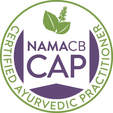|
An Ayurvedic Perspective by Janet Shivani Chase There are many types of liver cleanses and liver flushes promoted today. Would you benefit from doing a liver cleanse? As with anything in Ayurveda, it depends. As we are all unique, with specific health circumstances and constitutions, we need to look at our own situation before deciding. The liver is an amazing and complex organ that transforms everything we eat, breathe, and absorb through the skin into life sustaining nutrients. As the largest organ in the body, the liver performs more than 500 important functions. A few of its tasks are: to create bile; filter toxins from the blood; metabolize and regulate levels of fats, proteins and carbohydrates; store energy, vitamins, and minerals; help blood clot; destroy old blood cells; and produce cholesterol to help carry fats, create hormones, and make substances that are used in digestion.
Western medicine considers the liver to be part of the digestive system, but Ayurveda considers it to be the root of rakta vaha srotas—or the oxygen carrying part of blood (rakta dhatu)—and for good reason. Blood flows directly from the heart and the GI tract through the liver to be extracted, sorted, processed, altered, detoxified, stored, or passed back into the bloodstream to be distributed throughout the body carrying vital nutrients with it. One of the most important products the liver creates is bile. Indeed, the word pitta literally translates as bile. After ranjaka pitta in the liver produces bile, it is stored in the gallbladder to be released as needed to break down fats and to absorb fat-soluble vitamins. Furthermore, it helps to regulate beneficial and harmful microbes in the intestines, and to help digest fats, proteins, and carbohydrates. Bile is critical in the body’s detoxification process as it eliminates harmful organisms and carries waste and toxins out of the body. Since pitta plays a key role in the function of the liver, it is helpful to know if this dosha is balanced. The Ayurvedic Profile™ quiz is a good resource for determining the state of pitta in your body. The 5 Digestive Fires Considered in Ayurveda a hot and fiery organ, the liver contains five of the thirteen main agnis, or digestive fires of the body. Known as bhuta agni, these five agnis--nabhasa agni (ether), vayuva agni (air), tejo agni (fire), apas agni(water) and parthiva agni (earth)5—transform the five elements (bhutas) in the foods we ingest into the nutrients the body can use. After the bhuta agnis have done their job, the nutrients are passed on through the bloodstream to nourish the tissues of the body. Why a Healthy Liver Is Important Even if we live a clean lifestyle, we are constantly exposed to contaminants in our air, food, and water. The liver is bombarded by toxins—preservatives, solvents, heavy metals, pesticides, plastic residues, fungicides, fertilizers, alcohol, smoking, and pharmaceutical, OTC, and recreational drugs. Paint fumes, hair dyes, skin tattoos, amalgam dental fillings, canned foods, aluminum or copper cooking pots, copper water pipes, household cleaners, hormone pills, and cosmetics are additional sources that can damage the liver. Most processed foods as well as conventional meat and dairy contain pesticides, drugs, GMO residue, steroids, and hormones. Oily, greasy, fried foods, refined sugars, and grains are stressors as well. As the liver is mainly a pitta organ, when overtaxed it is the site of many pitta imbalances such as excessive sweating, ulcers and hyperacidity, and rosacea. It also may manifest as loss of appetite, nausea, vomiting, liver spots on the skin, changes in elimination, fatigue, lack of motivation, depression, anxiety, and memory problems. Additionally, when the work of the liver is disturbed by an overload of toxins, the transformation of food into nutrition is hindered which leads to depletion. When toxins are not efficiently transformed or eliminated they may end up circulating in the bloodstream creating the perfect recipe for disease to manifest. Emotions Can Affect the Liver The liver is considered to be the seat of pitta emotions such as courage, enthusiasm, cooperation, contentment, and surrender. However, it is also the seat of the more pernicious emotions of anger, hate, envy, impatience, ambition, frustration, and resentment. Those with more pitta predominance in their constitution are more prone to these emotions. When these emotions are repressed they are stored in the liver where they can change the flora of the gallbladder and intestines which can lead to dysfunction. Excess pitta in the liver leads to more of these negative emotions and these negative emotions in turn can cause damage to the liver. For this reason, we benefit if we digest these emotions fully and release them. The most important way to release them is to meditate and focus on releasing old pain, anger, and resentments. This will lighten and nourish the liver and body in turn. “The state of ill health is a moment to moment happening. Healing is moment to moment balance, bringing awareness to our thoughts, feelings and emotions and how we respond.”—Dr. Vasant Lad Ayurvedic Techniques for Liver Support Ayurveda teaches us that prevention is the key to well-being and favors a natural and gentle approach to supporting the body’s innate detoxification process. Ultimately, the best thing you can do for your liver is to treat it well. Fortunately, by supporting the health of your liver you increase the body’s ability to detoxify itself. One of the easiest ways to protect, nourish, and cleanse the liver is to be conscious of what you take into it. Eating a balanced, healthy, whole foods diet will go a long way to keeping you well. Choose organic, fresh, unprocessed, locally grown foods. Bitter, sweet and astringent foods such as garlic, lemons, grapefruit, beets, cruciferous and dark green leafy vegetables, artichokes, walnuts, apples, avocados, mung beans, celery, radish, leeks, carrots, and asparagus specifically cleanse the liver (and decrease pitta). Generally, spring is the best time to add extra support for the liver as we are drawn to eat more of the foods that naturally detoxify it. In addition, you might consider doing an Ayurvedic cleanse at this time of year to give the liver a rest from toxic inputs. You can read more about this in An Introduction to Ayurvedic Cleansing. “The food you eat can be either the safest and most powerful form of medicine or the slowest form of poison.”—Ann Wigmore More Tips for Liver Support There are many things we can do on a day-to-day basis to support our liver, which in turn supports our health. Take your time and incorporate each practice into your life until it becomes a habit. Then it is easy.
Ayurveda has been utilizing bitter herbs for thousands of years for strengthening and rejuvenating the liver and for supporting natural elimination of toxins from the blood. Some of the most important herbs used are turmeric, manjistha, guduchi, neem, bhumyamalaki, bhringaraj, amalaki, coriander, and kutki. Two Banyan Botanicals formulas that combine several of these liver supporting herbs are Liver Formula and Blood Cleanse. As with any herb, it is best to know your prakriti (constitution) and your vikriti (current state of health) before taking herbs as they can either decrease or increase the doshas. If you do not know your prakriti or vikriti, take the Ayurvedic Profile™ quiz. “The human being has enormous resources in the power to heal. And in those resources lie things that we ourselves need to clear or feel.”—Maya Tiwari Should You Consider a Liver Flush or Cleanse? There are many types of liver cleanses and liver flushes promoted today. Would you benefit from doing a liver cleanse? As with anything in Ayurveda, it depends. As we are all unique, with specific health circumstances and constitutions, we need to look at our own situation before deciding. We must consider our vikriti and our prakriti. We must determine whether ama is present and, if it is, where it is located. We need to prepare the path of elimination so the toxins have somewhere to go. Detoxification should always be soothing to prevent creating new problems. Most of today’s popular flushes involve fasting and purging by taking in a large amount of substances such as lemon juice, olive oil, and Epsom salts. As most liver flushes are harsh on the body and weaken agni (the digestive fire), vata dominant individuals must be especially cautious in considering one. If you attempt a flush without adequate preparation, you may actually do more harm than good by redistributing the toxins instead of eliminating them. If you flush too much bile out at once, the toxins may just resettle in the liver again. A strong liver cleanse or flush is not recommended if you have had a recent fever, weak digestion, hemorrhoids, ulcers, colon issues such as Crones Disease, IBS, diarrhea, or constipation, diabetes, hypoglycemia, heart disease, Tuberculosis, are very old, very young, weak, debilitated, emaciated, pregnant, or have a prolapse of stomach or uterus.9 For deeper cleansing, Ayurveda turns to panchakarma, its gentle—yet profound—process of detoxification, done under the guidance of an experienced practitioner. During panchakarma, different techniques are used to loosen toxins and excess doshas in the body and eliminate them through five therapeutic methods. Virechana is therapeutic purging specifically used to eliminate excess pitta and toxins from the digestive tract. The beauty of panchakarma is that each session is tailored specifically to each person’s unique needs. An Ayurvedic practitioner is trained to determine which of your doshas, dhatus, and srotas are affected and determine which, if any, type of cleanse and which herbal combination would be most beneficial for you. A healthy supported liver is essential for good health. Your body is telling you what it needs. Pay attention as you remember to love and nurture yourself and you will bring vitality, joy, and enthusiasm into your life and into the world. I hope this supports you on your path to wholeness and wish you well. In love and light, Shivani It is always recommended that clients work with their physicians for routine medical care and treatment of illness. Check with your doctor before taking herbs or using essential oils, especially when pregnant or nursing.
1 Comment
|
Affiliate LinksSome of the links provided are affiliate links, which cost you nothing, but pay me a small commission to help support my little blog. Disclaimer
I am certified as an Ayurvedic Practitioner. I am not a medical doctor nor a dietitian, and I do not diagnose, treat or cure disease. My articles are not a substitute for medical advice. It is always recommended that clients work with their physicians for routine medical care and treatment of illness. Check with your doctor before taking herbs or using essential oils, especially when pregnant or nursing.
Please read my full Disclaimer. Archives
September 2021
|

Contact: [email protected] [email protected] 918-457-9315
© 2021 Balanced Life Ayurveda, LLC All Rights Reserved
Disclaimer

 RSS Feed
RSS Feed